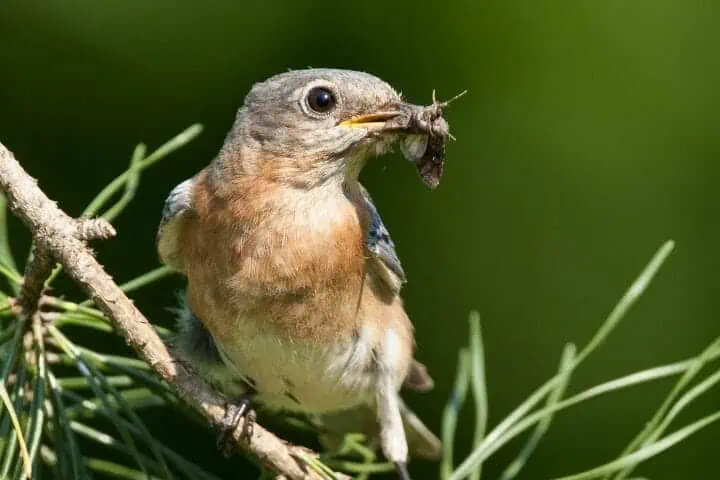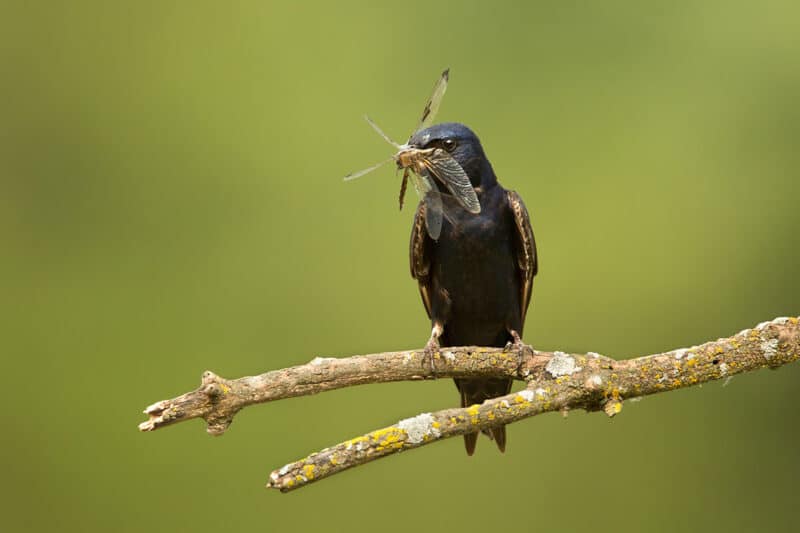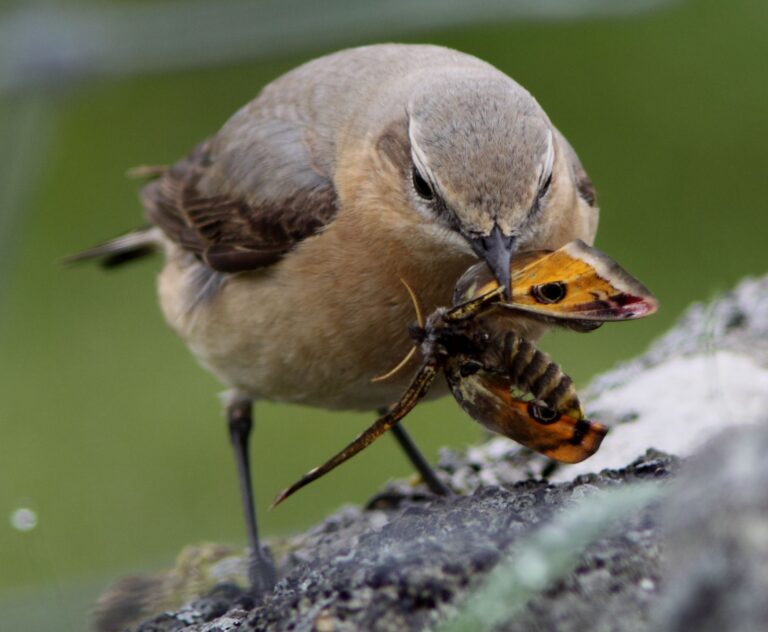Many bird species, especially insectivorous ones, do eat moths, which are attracted to light sources at night. Birds like nightjars, nighthawks, swifts, swallows, and some bats hunt moths in the dark. Moth caterpillars are also consumed by various songbirds. However, a bird’s diet can vary based on its species and habitat.
How do nightjars catch moths in flight?
These bird species have adapted various physical and behavioral characteristics to effectively hunt moths.
Furthermore, their hunting methods are specialized for capturing flying insects, and they play a vital role in controlling moth populations, particularly in their respective habitats.
Nightjars (Family: Caprimulgidae): Nightjars are nocturnal birds known for their moth-catching abilities.
They have large, wide mouths and specialized bristle-like feathers around their mouths, which help them catch moths and other flying insects in mid-air. Nightjars often hunt moths in flight during the twilight hours or at night.
Nighthawks (Family: Caprimulgidae): Nighthawks are closely related to nightjars and share similar hunting habits. They are crepuscular or nocturnal birds that feed on moths and other flying insects. Their long wings and buoyant flight enable them to capture moths in mid-air with agility.
Swifts (Family: Apodidae): Swifts are highly aerial birds with a diet primarily composed of insects, including moths.
Moreover, they are known for their rapid and agile flight, allowing them to catch moths on the wing. Swifts often feed on moths during their migratory flights as well.
Swallows (Family: Hirundinidae): Swallows are insectivorous birds that include moths in their diet. They are skilled aerial hunters, swooping and darting to catch moths in flight.
Swallows are often seen foraging for moths over bodies of water and open fields.
Description of their hunting methods

Nightjars and Nighthawks: These birds have a cryptic plumage that provides excellent camouflage during daytime roosting.
At dusk or during the night, they become active and use their large, gaping mouths to catch moths in flight.
Nightjars and nighthawks are known for their silent flight, which enables them to approach moths stealthily.
Swifts: Swifts have long, slender wings and a rapid, continuous flight pattern. Moreover, they are adept at catching moths in mid-air due to their exceptional maneuverability.
Swifts often hunt in flocks, making coordinated efforts to capture flying insects, including moths.
Swallows: Swallows have streamlined bodies and pointed wings, which facilitate their agile flight. They are often seen flying low over fields, water, or open spaces, where they hunt moths.
In addition, swallows use their beaks to snatch moths during flight, and their acrobatic flight style allows them to change direction quickly.
Why are moths attracted to light and vulnerable to predators?
Moths’ attraction to light sources, coupled with their vulnerability to predation, makes them a vital food source for many insectivorous birds.
Moths’ attraction to light sources
Phototaxis: Moths exhibit a behavior known as phototaxis, which means they are naturally attracted to sources of light. This behavior is especially prominent at night when moths are most active.
Navigational Confusion: Moths’ attraction to artificial lights can often lead to navigational confusion and disorientation.
In addition, they tend to circle around artificial lights, which can sometimes prove fatal as they may exhaust themselves or become more visible to predators.
Ecological Implications: The phenomenon of moths being drawn to artificial light sources has ecological implications.
Furthermore, it can concentrate moths in certain areas, making them more accessible to nocturnal predators, including birds.
Vulnerability of moths to predation
Limited Defenses: Moths, in their adult stage, generally have limited defenses against predators. Unlike some insects with protective coloration or toxins, moths primarily rely on their nocturnal behavior and flight capabilities to escape predators.
Slow Flight: While moths are agile fliers, they tend to have slower flight speeds compared to many birds, making them more susceptible to being caught during flight.
Predation Hotspots: Light sources, such as street lamps or porch lights, create predation hotspots where moths are concentrated.
Furthermore, this makes it easier for predators like bats, birds, and even some insects (like mantises) to intercept and capture them.
Role of moths in the diet of insectivorous birds
Dietary Component: Moths are a significant dietary component for many insectivorous bird species, especially those that are active during twilight and at night.
Nutritional Value: Moths provide a rich source of nutrition for birds. They are energy-dense, containing fats and proteins, which are essential for the high metabolic demands of birds.
Seasonal Variation: The importance of moths in the diet of insectivorous birds can vary seasonally. During the breeding season, birds may rely heavily on moths to feed their nestlings due to their abundance and accessibility.
Ecosystem Balance: Insectivorous birds, including those that feed on moths, play a crucial role in controlling insect populations. By preying on moths and other insects, they help maintain ecological balance and limit potential pest outbreaks.
Conservation Significance: The presence of moths as a food source highlights the interdependence of different species within ecosystems. Conservation efforts for insectivorous birds can indirectly benefit moth populations and vice versa.
How do songbirds use moth caterpillars in their diets?

Understanding these variations is essential for comprehending the ecological roles of different bird species and their interactions with the insect world, including moths.
Moth caterpillars as a food source for songbirds
Diverse Diet: Songbirds, also known as passerines, have diverse diets that often include moth caterpillars. These caterpillars are the larval stage of moths and can be found on a wide range of plant species.
Caterpillar Preferences: Many songbird species have specific caterpillar preferences. For example, the caterpillars of some moth species may feed on particular plants, and songbirds that have evolved to exploit these food sources have developed specialized foraging techniques.
Nesting Requirements: Moth caterpillars are often an essential food source for songbirds during the breeding season. The high protein content of caterpillars is crucial for nestling growth and development.
Predatory Techniques: Songbirds employ various techniques to capture moth caterpillars. Some species glean caterpillars from leaves and branches, while others may hover or hover-glean to capture them in mid-air.
Variation in bird diets based on species and habitat
Dietary Specialization: Different bird species exhibit varying degrees of dietary specialization. While some birds are generalists and can adapt to a wide range of food sources, others have highly specialized diets.
Habitat Influence: Bird diets are often influenced by their specific habitats. For example, birds living in forests may have diets that include a higher proportion of insects like moths, while those in grasslands might consume more grasshoppers and other ground-dwelling insects.
Migration Considerations: Some birds alter their diets seasonally, especially during migration.
Moreover, they may rely more on insects like moths during the breeding season and switch to different food sources, such as fruits or seeds, during the non-breeding season.
Availability of Prey: Bird diets are also shaped by the availability of prey in their immediate environment.
In years with higher moth populations, birds may consume more moths, while in years with fewer moths, they may shift their diets accordingly.
Influence of Foraging Techniques: Birds employ various foraging techniques, such as ground foraging, aerial hawking, or probing tree bark. These techniques are adapted to their specific diets and habitats.
FAQ’s
Do moths eat clothes and why?
Moths do not actually eat clothes. Instead, it’s the moth larvae, specifically clothes moth larvae, that feed on natural fibers like wool, silk, and fur found in clothing items. They consume these materials for their protein content.
Do moths eat cotton?
Clothes moths primarily target animal-based fibers like wool and silk. While cotton is a natural fiber, it is plant-based and less attractive to clothes moth larvae. However, under certain conditions, they may infest cotton-blend fabrics if other food sources are scarce.
Do moths like clean or dirty clothes?
Clothes moths do not prefer clean or dirty clothes specifically. They are more attracted to clothes or fabrics that have food stains, sweat, or other organic residues because these substances can contain the protein they need for growth.
Do moths eat clean or dirty clothes?
Clothes moth larvae are more likely to infest clothes with organic residues, so they may be attracted to both clean and dirty clothes if those garments have food or sweat stains.
What kills moths?
Moths can be killed through various methods, including natural predators like birds and insects, chemical insecticides, freezing (which kills moth larvae), and maintaining proper storage conditions to prevent infestations.
Do moths damage clothes?
Yes, clothes moth larvae can damage clothing items made of natural fibers by feeding on them. They create holes or irregular patterns in the fabric, causing damage.
What attracts clothes moths?
Clothes moths are attracted to dark, undisturbed areas with high humidity and organic residues. They are drawn to the scent of sweat, food stains, and natural fibers in clothing. Proper storage and cleanliness help deter them.
Final Thought
In conclusion, the intricate relationship between birds and moths is a fascinating aspect of the natural world. Birds, such as nightjars, nighthawks, swifts, and swallows, have evolved specialized hunting methods to capture moths, which are naturally drawn to light sources at night.
In addition, these moths serve as a significant food source for these insectivorous birds, offering vital nutrition and playing a crucial role in controlling insect populations.
Moreover, moths’ attraction to light, coupled with their vulnerability to predation, creates ecological dynamics that extend beyond the immediate interaction between birds and moths.
Furthermore, this interconnectedness underscores the delicate balance of ecosystems and highlights the importance of understanding and conserving these complex relationships in our natural world.

